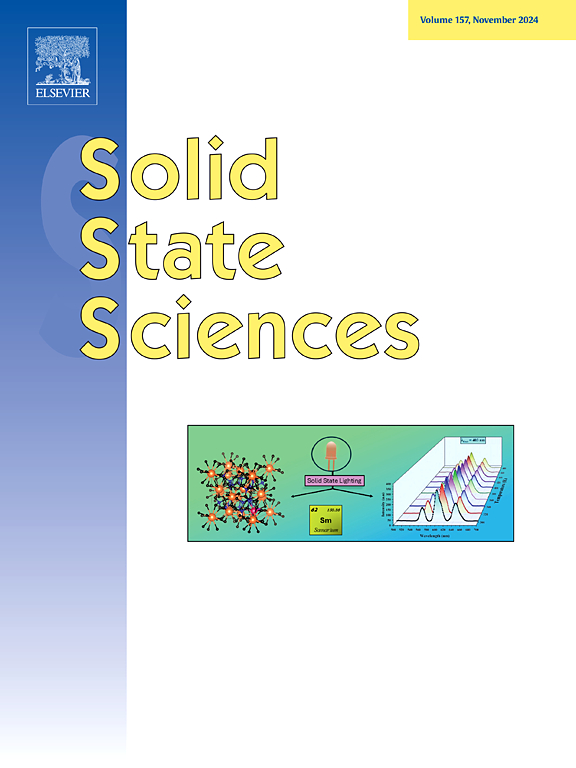热触发SiO2包覆赤霉素纳米颗粒的结构转变:ε-Fe2O3相的形成
IF 3.3
3区 化学
Q2 CHEMISTRY, INORGANIC & NUCLEAR
引用次数: 0
摘要
正交型ε-Fe2O3氧化铁多晶由于其有趣的磁性能和在高密度数据存储和高频毫米波屏蔽方面的潜在应用而引起了广泛的研究兴趣。本文报道了用不同的加热方式对二氧化硅包覆的赤霞石纳米颗粒进行热处理制备ε-Fe2O3多晶。通过各种实验技术对所得样品的形貌、结构和磁性进行了评估。在900℃以上煅烧的4个样品的透射电子显微镜(TEM)显示,得到的颗粒形状大致为椭圆形,平均粒径(DTEM)在13 ~ 23 nm之间。x射线衍射证实了ε-Fe2O3相的存在,α-Fe2O3相的添加量取决于加热方式。饱和磁化强度Ms范围为9.5 ~ 11.6 Am2/kg,室温矫顽力Hc范围为111.4 ~ 1002.7 kA/m (12.6 kOe)。在加热到930°C的样品中,通过在不同温度下的几个停留步骤获得了最高的Ms和Hc,而另一个样品也在930°C退火,但使用不同的加热路径,显示出明显较低的矫顽力Hc = 628.7 kA/m (7.9 kOe)。在较高的最终温度(940°C和1000°C)下退火也没有提高矫顽力,因为超顺磁粒子的数量增加了。研究结果强调了epsilon氧化铁前驱体样品热处理过程中不同参数的重要性。结果表明,由二氧化硅包覆的赤霉素纳米颗粒制备的ε-Fe2O3多晶体的磁性能可以通过精心选择的停留温度和时间进行多步加热来调节。本文章由计算机程序翻译,如有差异,请以英文原文为准。

Heat triggered structural transformation of SiO2 coated akaganeite nanoparticles: ε-Fe2O3 phase formation
Orthorhombic epsilon iron oxide polymorph ε-Fe2O3 still attracts extensive research interest due to its interesting magnetic properties and potential applications in high-density data storage and high-frequency millimeter electromagnetic waves shielding. The present paper reports on the fabrication of ε-Fe2O3 polymorph through thermal treatment of silica coated akaganeite nanoparticles using various heating protocols. Morphology, structure and magnetic properties of the resulting samples were assessed by various experimental techniques. Transmission electron microscopy (TEM) of the four samples calcined at temperatures above 900 °C showed that the obtained particles were roughly oval in shape with average particle diameters (DTEM), in the range from 13 nm to 23 nm. The X-ray diffractometry confirmed presence of prevailing ε-Fe2O3 phase with addition of α-Fe2O3 phase whose amount depended on the heating regime used. The saturation magnetization, Ms, values were in the range 9.5–11.6 Am2/kg, while the room temperature (RT) coercivity fields, Hc, ranged from 111.4 kA/m (1.4 kOe) to 1002.7 kA/m (12.6 kOe). The highest Ms and Hc were achieved in the sample heated up to 930 °C through several dwelling steps at different temperatures, while another sample also annealed at 930 °C but using different heating path, displayed substantially lower coercivity Hc = 628.7 kA/m (7.9 kOe). Annealing at higher final temperatures 940 °C and 1000 °C also did not improve coercivity due to increased number of superparamagnetic particles. Presented results emphasize importance of different parameters involved in the process of thermal treatment of epsilon iron oxide precursor samples. It was demonstrated that magnetic properties of the ε-Fe2O3 polymorph prepared from silica coated akaganeite nanoparticles can be tuned by employing a multistep heating protocol with carefully chosen dwelling temperatures and times.
求助全文
通过发布文献求助,成功后即可免费获取论文全文。
去求助
来源期刊

Solid State Sciences
化学-无机化学与核化学
CiteScore
6.60
自引率
2.90%
发文量
214
审稿时长
27 days
期刊介绍:
Solid State Sciences is the journal for researchers from the broad solid state chemistry and physics community. It publishes key articles on all aspects of solid state synthesis, structure-property relationships, theory and functionalities, in relation with experiments.
Key topics for stand-alone papers and special issues:
-Novel ways of synthesis, inorganic functional materials, including porous and glassy materials, hybrid organic-inorganic compounds and nanomaterials
-Physical properties, emphasizing but not limited to the electrical, magnetical and optical features
-Materials related to information technology and energy and environmental sciences.
The journal publishes feature articles from experts in the field upon invitation.
Solid State Sciences - your gateway to energy-related materials.
 求助内容:
求助内容: 应助结果提醒方式:
应助结果提醒方式:


